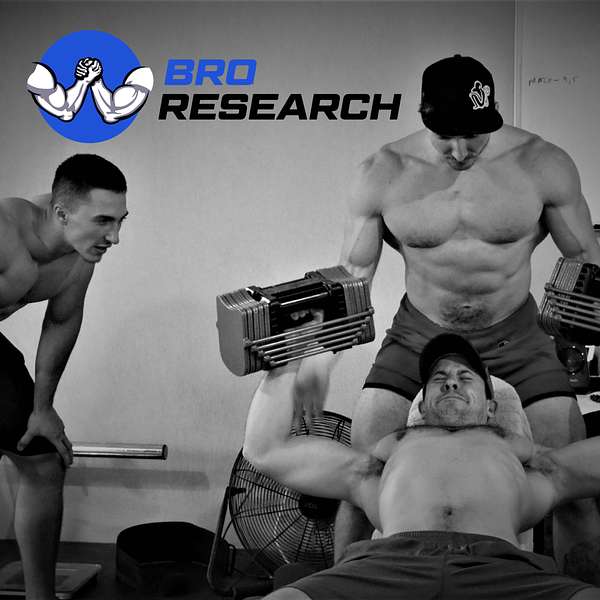
Bro Research Radio
Bro Research Radio
Episode 17 - Metabolic Stress
In this Episode Ryan and Ben dive into both the mechanistic and applied research, as well as discuss the practical applications of using lower-load shorter-rest training. #ThePump
References related to this episode to check out:
1. Agostinete RR, Rossi FE, Magalhaes AJ, et al. Immunometabolic Responses after Short and Moderate Rest Intervals to Strength Exercise with and without Similar Total Volume. Frontiers in physiology. 2016;7:444.
2. Ahtiainen JP, Pakarinen A, Alen M, Kraemer WJ, Hakkinen K. Short vs. long rest period between the sets in hypertrophic resistance training: influence on muscle strength, size, and hormonal adaptations in trained men. J Strength Cond Res. 2005;19(3):572-582.
3. de Souza TP, Jr., Fleck SJ, Simao R, et al. Comparison between constant and decreasing rest intervals: influence on maximal strength and hypertrophy. J Strength Cond Res. 2010;24(7):1843-1850.
4. Drouin PJ, Kohoko ZIN, Mew OK, Lynn MJT, Fenuta AM, Tschakovsky ME. Fatigue-independent alterations in muscle activation and effort perception during forearm exercise: role of local oxygen delivery. Journal of applied physiology. 2019;127(1):111-121.
5. Fink J, Kikuchi N, Nakazato K. Effects of rest intervals and training loads on metabolic stress and muscle hypertrophy. Clin Physiol Funct Imaging. 2018;38(2):261-268.
6. Freitas MC, Cholewa J, Panissa V, et al. Short-Time beta-Alanine Supplementation on the Acute Strength Performance after High-Intensity Intermittent Exercise in Recreationally Trained Men. Sports (Basel). 2019;7(5).
7. Goto M, Maeda C, Hirayama T, et al. Partial Range of Motion Exercise Is Effective for Facilitating Muscle Hypertrophy and Function Through Sustained Intramuscular Hypoxia in Young Trained Men. J Strength Cond Res. 2019;33(5):1286-1294.
8. Grgic J, Lazinica B, Mikulic P, Krieger JW, Schoenfeld BJ. The effects of short versus long inter-set rest intervals in resistance training on measures of muscle hypertrophy: A systematic review. European journal of sport science. 2017;17(8):983-993.
9. Haun CT, Mumford PW, Roberson PA, et al. Molecular, neuromuscular, and recovery responses to light versus heavy resistance exercise in young men. Physiol Rep. 2017;5(18).
10. Haun CT, Vann CG, Mobley CB, et al. Pre-training Skeletal Muscle Fiber Size and Predominant Fiber Type Best Predict Hypertrophic Responses to 6 Weeks of Resistance Training in Previously Trained Young Men. Frontiers in physiology. 2019;10:297.
11. Mitchell CJ, Churchward-Venne TA, Bellamy L, Parise G, Baker SK, Phillips SM. Muscular and systemic correlates of resistance training-induced muscle hypertrophy. PLoS One. 2013;8(10):e78636.
12. Morton RW, Sonne MW, Farias Zuniga A, et al. Muscle fibre activation is unaffected by load and repetition duration when resistance exercise is performed to task failure. J Physiol. 2019;597(17):4601-4613.
13. Rossi FE, Gerosa-Neto J, Zanchi NE, Cholewa JM, Lira FS. Impact of Short and Moderate Rest Intervals on the Acute Immunometabolic Response to Exhaustive Strength Exercise: Part I. J Strength Cond Res. 2016;30(6):1563-1569.
14. Schoenfeld BJ, Pope ZK, Benik FM, et al. Longer Interset Rest Periods Enhance Muscle Strength and Hypertrophy in Resistance-Trained Men. J Strength Cond Res. 2016;30(7):1805-1812.
15. Villanueva MG, Lane CJ, Schroeder ET. Short rest interval lengths between sets optimally enhance body composition and performance with 8 weeks of strength resistance training in older men. European journal of applied physiology. 2015;115(2):295-308.